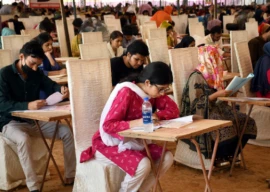
The recent report regarding terrorism in Sindh compiled by the Crime Investigation Department (CID) of the province is one such report. A curious blend of historical facts with contemporary phenomena, the report ends up positing some self-evident ‘truths’ and concludes with some far-fetched theories on what has happened.
The truly worrying bit, caution security analysts is that if the CID which is supposed to be the intelligence arm of the police and liaises with the intelligence apparatus doesn’t know, who does? The report begins with the premise that al Qaeda and the Taliban have created a nexus with sectarian outfits based in the city. To support this, a list of the links of terrorists arrested by the CID is furnished.
Of the 246 terrorists apprehended between August 2001 and now, a staggering 94 belong to the Lashkar-e-Jhangvi, 12 to the Sipah-e-Sahaba, 40 to the Harkatul Mujahideen al Alami, 36 to the “Tehreeke- Taliban Pakistan/al Qaeda” while another eight are “Shia militants”. Others are from the Jundullah, Tehreek-e- Jafria, Sunni Tehreek and Lashkar-e-Islami.
The “Observations” section is perhaps the most interesting bit of the report. Almost all terrorists, it is said, have trained in Afghanistan and on arrival in Karachi, form the “nucleus” of small groups on their return. The emergence of “diehard militants” the report puts down to either incarceration or “harrowing experiences at the hands of Western powers.” Significantly, the report says that all the groups provide logistical support and manpower to each other and to al Qaeda and the TTP.
Security analysts wellversed with the demographics of the city, however, aren’t willing to buy these claims. “9/11 changed a lot of realities here,” argues ex-Citizens Police Liaison Committee chief Jameel Yusuf. “Before 9/11, there was a clear operational strategy: training was conducted in Afghanistan, after that the militants were fed to Kashmir. They were united by a common purpose that was Kashmir. That ‘central command’ or ‘unifying principle’ collapsed after 9/11.”
The new strain of militants in Karachi, argues Yusuf, doesn’t ‘share’ and, more significantly, has no master plan. Major General Jamshed Ayaz of the Islamabad-based think-tank, the Institute of Regional Studies tends to agree. “If the militants help each other, it’s for small issues – they don’t have a single ‘motive’ or a central command.” This, argues Ayaz, is critical for their survival. “Their survival depends on their operating in small units which can seamlessly disappear,” he contends.
Some of these issues were discovered during the hunt for the Times Square bomber Faisal Shahzad, when some media reports suggested the law enforcement agencies had arrested Shahzad’s alleged handlers. Although the authenticity of these claims is still to be verified, a Crime Investigation Department official involved with the report said militants had split into ‘very small’ groups—sometimes of two or three men— which intelligence outfits find difficult to penetrate.
Besides having fewer members, the official added, these groups are totally incommunicado even to other similar cells—a fact that confuses security agencies. “That is why,” the official said, “It is almost impossible to trace their roots; if some of them are caught, interrogators cannot reach their origin.” The report also touches upon the issue of financing. Whereas ‘old school’ jehadis depended on donations from madrassahs and religious charities for funds, the new strain is said to be increasingly resorting to crimes such as bank robberies, extortion, kidnapping for ransom, drug trafficking and hijacking of goods and vehicles to collect money.
Interestingly, the report also admits to the role played by the madrassahs of Karachi. It says that while many madrassahs sent their students for jihad in the region, a large number also served as “the ideological breeding ground for the [al Qaeda]/Taliban/ TTP brand of ideology.” The report goes on to state that while Karachi was relatively safe during 2008-09 since it was a haven for “displaced and injured terrorists”, recent blasts show that terrorists and their “affiliates” have the ability to undertake “big operations in Karachi and interior Sindh.” It also cautions against the possible exploitation of the situation by “foreign powers” looking to aggravate the law and order situation.
And as a final note, the report suggests that the new-age militants may not just confine themselves to suicide bombings but could also resort to use of “IEDs, vehicle-based bombs, sniping, [rocket-propelled grenades], rockets/missiles” and even novel methods of poisoning food and water supplies. While the poison theory doesn’t have too many takers, others are worried about the impact historicity will have on militancy in Pakistan.
“The groups who were in Afghanistan were led by either Afghan or Arab commanders,” says Yusuf. “Had these commanders been Pakistani, Pakistan wouldn’t have been in such bad shape perhaps because there could have been some sense of belonging. There’s nothing stopping the foreign commanders from coming to Pakistan.” he said. This, in spite of the fact that many of the ‘foreigners’ ended up marrying Pakistani women after they settled here. The report also warns of changing tactics: multiple, concerted attacks; the destruction of bridges and the use of the new generation of IEDs. Keeping a tighter watch, argues the CID official, is of little use.
“Most of the groups are based in Pakhtun-dominated middle-class localities of the city – Benaras, Sohrab Goth, Waziristan Colony, Nazimabad and Numaish – which are at times too crowded to be watched closely,” he maintains. Commenting on the report, security analyst and former Intelligence Bureau chief Masood Sharif Khattak termed the situation in Karachi as ‘volcanic’ that can erupt anytime if the state does not take appropriate measures.
“The germs of violence are already there. There is no dearth of illegal arms, illegal immigrants and all this makes the city more vulnerable than any other place,” Khattak says.








1724319076-0/Untitled-design-(5)1724319076-0-270x192.webp)
1726732405-0/Express-Tribune-Web-(15)1726732405-0-270x192.webp)

1735025557-0/Untitled-(96)1735025557-0-270x192.webp)











COMMENTS
Comments are moderated and generally will be posted if they are on-topic and not abusive.
For more information, please see our Comments FAQ